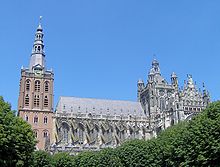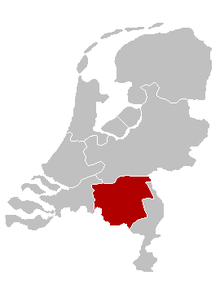Apostolic Vicariate of ’s-Hertogenbosch
|
Diocese of 's-Hertogenbosch Dioecesis Buscoducensis Bisdom den Bosch |
|
|---|---|

|
|
| Location | |
| Country | Netherlands |
| Statistics | |
| Area | 3,826 km2 (1,477 sq mi) |
| Population - Total - Catholics |
(as of 2014) 2,101,000 1,101,000 (52.4%) |
| Information | |
| Denomination | Roman Catholic |
| Rite | Latin Rite |
| Established | 12 May 1559 |
| Cathedral | Cathedral Basilica of Saint John the Evangelist |
| Current leadership | |
| Pope | Francis |
| Bishop | Gerard de Korte |
| Metropolitan Archbishop | Cardinal Wim Eijk |
| Auxiliary Bishops | Robertus G. L. M. Mutsaerts |
| Map | |
 Location of the Diocese of 's-Hertogenbosch |
|
| Website | |
| www.BisdomDenBosch.nl | |
The Roman Catholic Diocese of 's-Hertogenbosch (Latin: Dioecesis Buscoducensis) is a diocese of the Catholic church in the Netherlands. The modern diocese was created in 1853. It is a suffragan of the archdiocese of Utrecht. It is currently led by bishop Gerard de Korte. Its see is St. John's Cathedral, 's-Hertogenbosch.
The city of 's-Hertogenbosch (Hertzogenbusch, Sylva Ducis) was founded in 1184, but with the surrounding territory, was included in the Diocese of Liège until 12 March 1561. At that time, and in order to check the spread of Protestantism, Pope Pius IV raised it to the dignity of a see, and made it suffragan to the archdiocese of Mechelen. The first bishop was the theologian Francis Sonnius (1562–69), afterwards transferred to the see of Antwerp. His successors suffered in the political disorders and wars of the last quarter of the sixteenth century. When after a long siege the city was captured by Prince Frederick Henry (14 September 1629) and held in the name of the States-General, the sixth bishop, Michael Ophovius, was obliged to abandon his see, which he did in a solemn procession, surrounded by his clergy, and bearing with him a famous miraculous statue of the Blessed Virgin which he placed in safety at Brussels.
Joseph de Bergaigne (1638–47) was really little more than bishop in name. He was unable to assert his right to the office, and lived an exile. By the Treaty of Westphalia (1648) the entire territory of the diocese was recognized as a permanent conquest of the Dutch Republic, and made directly subject to their jurisdiction, i.e. to the States-General. The exercise of the Catholic religion was forbidden by law, and the pertinent decrees were applied with rigour. Catholic priests, however, continued secretly their ministry. The diocese became a simple mission, governed by a vicar-Apostolic, nearly always, however, a titular bishop.
...
Wikipedia
